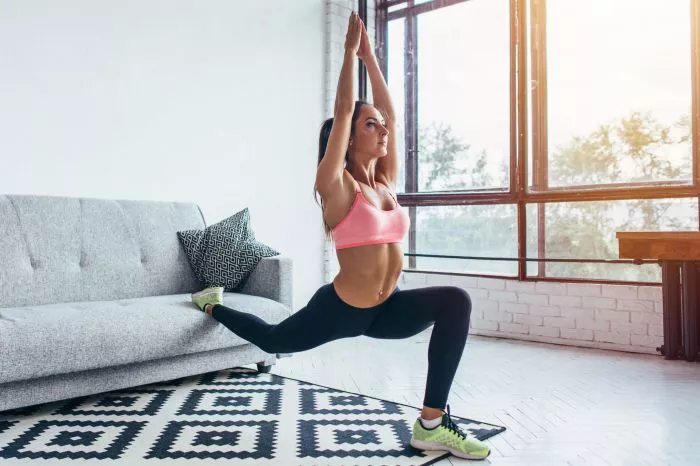Understanding Squat Lunges:
Squat lunges are a combination exercise that incorporates elements of both squats and lunges. In a squat lunge, you perform a squat followed by a lunge, alternating between the two movements to target different muscle groups in your lower body. This dynamic exercise challenges your leg muscles, core stability, and balance while providing a comprehensive lower-body workout.
Benefits of Squat Lunges:
Leg Strength and Endurance: Squat lunges engage multiple muscle groups in your lower body, including the quadriceps, hamstrings, glutes, and calves. By performing this compound exercise, you can develop strength and endurance in these muscles, leading to improved functional movement and athletic performance.
Balance and Coordination: The dynamic nature of squat lunges requires coordination and balance to perform the movements effectively. By incorporating balance and stability challenges into your workout routine, you can enhance proprioception and coordination, which are essential for overall athleticism and injury prevention.
Core Activation: Squat lunges require core stability to maintain proper form throughout the exercise. By engaging your core muscles, including the abdominals, obliques, and lower back, you can improve core strength and stability, which translates to better posture and spinal alignment.
Functional Movement Patterns: Squat lunges mimic common functional movements such as bending, lifting, and stepping, making them beneficial for everyday activities and sports-specific training. By training these movement patterns with resistance, you can enhance your ability to perform daily tasks with ease and reduce the risk of injury during physical activities.
Versatility and Convenience: Squat lunges can be performed using body weight alone or with added resistance such as dumbbells, barbells, or kettlebells, making them suitable for individuals of all fitness levels. Additionally, they can be incorporated into various workout routines, including circuit training, HIIT (high-intensity interval training), or functional training, providing versatility and convenience for achieving your fitness goals.
How to Perform Squat Lunges Properly:
Start Position: Stand with your feet hip-width apart, toes pointing forward, and your back straight. Engage your core muscles and maintain a neutral spine throughout the exercise.
Squat Phase: Begin by performing a squat. Lower your hips back and down as if sitting back into a chair, keeping your chest lifted and knees aligned with your toes. Descend until your thighs are parallel to the ground or as low as comfortable while maintaining proper form.
Transition: From the bottom of the squat position, shift your weight onto one leg and prepare to transition into a lunge.
Lunge Phase: Step back with one foot, lowering your back knee toward the ground while keeping your front knee aligned with your ankle. Your front thigh should be parallel to the ground, and your back knee should hover just above the floor. Ensure your torso remains upright, and your chest is lifted throughout the movement.
Return to Start Position: Push through your front heel to return to the standing position, driving upward with both legs simultaneously. As you rise, bring your back foot forward to meet the other foot.
Alternate Sides: Repeat the sequence on the opposite side, stepping back with the other leg to perform a lunge. Continue alternating between squats and lunges for the desired number of repetitions or time duration.
Breathing: Inhale as you lower into the squat or lunge phase, and exhale as you return to the starting position or transition between movements. Maintain a steady and controlled breathing pattern throughout the exercise to optimize oxygen flow and energy expenditure.
Form Tips: Keep your chest lifted, shoulders relaxed, and gaze forward to maintain proper alignment and prevent rounding of the spine. Ensure your knees track in line with your toes during both the squat and lunge phases, avoiding excessive inward or outward movement. Focus on controlling the movement with your leg muscles rather than relying solely on momentum.
Modifications and Progressions: Depending on your fitness level and goals, you can modify the intensity of squat lunges by adjusting the depth of your squat or lunge, increasing or decreasing the range of motion, or adding external resistance such as weights or resistance bands. Additionally, you can progress the exercise by performing plyometric variations, such as jump lunges or squat jumps, to increase power and explosiveness.
Cool Down and Stretching: After completing your squat lunge workout, incorporate a cool-down period consisting of gentle cardiovascular exercise and static stretching to promote muscle relaxation and flexibility. Focus on stretching the muscles targeted during the workout, including the quadriceps, hamstrings, glutes, and calves, holding each stretch for 15-30 seconds without bouncing.
Conclusion
In conclusion, squat lunges are an effective compound exercise that targets multiple muscle groups in the lower body while improving balance, coordination, and core stability. By performing squat lunges with proper form and technique, you can reap the many benefits they offer and enhance your overall strength, endurance, and functional fitness. Incorporate squat lunges into your workout routine to take your lower-body training to the next level and achieve your fitness goals.
Related Topics:
Is Hot Yoga Considered Cardio?


